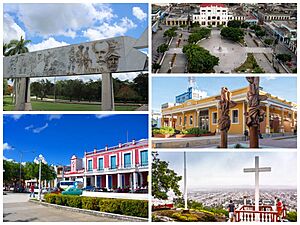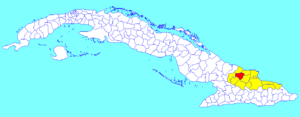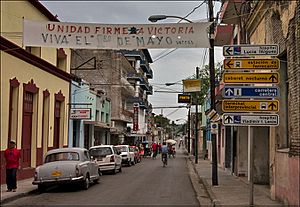Holguín facts for kids
Quick facts for kids
Holguin
San Isidoro de Holguin
|
|||
|---|---|---|---|
 |
|||
|
|||

Holguín municipality (red) within
Holguín Province (yellow) and Cuba |
|||
| Country | Cuba | ||
| Province | Holguín | ||
| Metro Zone | Holguín Metro District | ||
| Established | 1523 | ||
| Area | |||
| • Municipality | 690 km2 (270 sq mi) | ||
| Elevation | 5 m (16 ft) | ||
| Population
(2022)
|
|||
| • Municipality | 355,189 | ||
| • Density | 515/km2 (1,333/sq mi) | ||
| • Urban | 309,615 | ||
| • Rural | 45,574 | ||
| • Metro | 1,006,834 (Province) | ||
| Demonym(s) | Holguinero,-a | ||
| Time zone | UTC-5 (EST) | ||
| • Summer (DST) | UTC-4 | ||
| Area code(s) | +53 24 | ||
| Vehicle registration | O | ||
Holguín is a big city and a municipality in Cuba. It's the fourth largest city in Cuba, after Havana, Santiago de Cuba, and Camagüey.
Contents
History of Holguín
Before Christopher Columbus arrived, the Taino people lived in the Holguín area. They built their homes from royal palm trees. You can see some of their old tools and art at the La Periquera museum in Holguín today.
The city was started in 1523. Diego Velázquez de Cuéllar gave land to Captain Francisco García Holguín, a Spanish military officer. Captain Holguín added his family name to the town's name, calling it San Isidoro de Holguín.
In September 2015, before visiting the United States, Pope Francis visited Cuba. One of his stops was in Holguín. He came to remember the place where Christopher Columbus first landed in Cuba.
Geography of Holguín
The municipality of Holguín is divided into smaller areas called repartos or barrios. In the past, the municipality was much larger. Many of the areas that used to be part of Holguín are now in other municipalities.
However, some areas still belong to Holguín today. These include Aguas Claras, Guirabo, La Cuaba, Las Calabazas, Purnio, San Andrés, and Yareyal.
Economy in Holguín
Holguín is home to the Cervecería Bucanero brewery. This company makes three popular kinds of beer: Bucanero, Cristal, and Mayabe.
There are also several hotels in and around the city. Some small hotels, like Villa El Quinque and Villa El Cocal, are near the Frank País Airport. They focus on health tourism, which means people visit them for health and wellness.
In the city center, you'll find hotels like Pernik and El Bosque. More recently, smaller, special hotels called "boutique hotels" have opened. These include Caballeriza, Esmeralda, and Saratoga. They offer unique places to stay for visitors.
Population of Holguín
In 2004, about 326,740 people lived in the municipality of Holguín. The area of the municipality is about 658 square kilometers (254 square miles). This means there were about 497 people living in each square kilometer.
By 2012, the population grew a bit to 346,195 people. The population density also increased to about 520 people per square kilometer.
What to See and Do in Holguín
Holguín has many lovely city parks where you can relax. Some of these include Parque Infantil, Parque San José, Parque San Isidoro (Las Flores), and Parque Martí. The most central park is Calixto García Park in the downtown area.
Near the main park, you can find art galleries like Centro Provincial de Arte and Bayado. There's also a library, a music club called Casa de la Trova, and the Martí cinema. You can also visit the Theatre Eddy Suñol, the Province Museum La Periquera, a science museum, and a history museum.
One of the most famous places in Holguín is the Loma de la Cruz (which means "Hill of the Cross"). You can climb over 450 stairs to reach the top of this hill. From there, you get an amazing view of the entire city! Long ago, people put a large cross on this hill. They believed it would protect the city from bad things coming from the north.
Holguín also has a baseball stadium. It's named after Calixto García, a famous Cuban general.
Getting Around Holguín
Holguín has an airport called Frank País Airport. Its code is HOG. You can fly from here to Havana and many other places around the world, especially in Canada and Europe.
Education in Holguín
Holguín has several important schools for higher education. The main one is the University of Holguín "Oscar Lucero Moya". This is a big university where students can study many different subjects.
Other important schools include:
- The University of Medical Sciences "Mariana Grajales", where students study to become doctors and other healthcare professionals.
- The Pedagogical University of Holguín "José de la Luz y Caballero", which trains future teachers.
- The University of Sports "Manuel Piti Fajardo", where students learn about physical education and sports.
Famous People from Holguín
Many talented people come from Holguín, including:
- Faustino Oramas, a Cuban composer and musician.
- Mario Kindelán, an Olympic Gold Medalist in boxing.
- Fredi González, a baseball manager and coach.
- Eglise Gutiérrez, an opera singer.
- Reinaldo Arenas, a poet and novelist.
- Oscar Hijuelos, a Cuban-American author who won a Pulitzer Prize. His parents were from Holguín.
- Puntillita (Manuel Licea), a popular Cuban singer.
- Aroldis Chapman, a Major League Baseball player.
- Odalis Revé, an Olympic Gold Medallist in judo.
Sister Cities
Holguín has "sister city" relationships with other cities around the world. This means they share cultural ties and friendly connections.
 Santa Fe, New Mexico, United States
Santa Fe, New Mexico, United States Saltillo, Coahuila, Mexico
Saltillo, Coahuila, Mexico Yazd, Yazd Province, Iran
Yazd, Yazd Province, Iran
See also
 In Spanish: Holguín para niños
In Spanish: Holguín para niños





